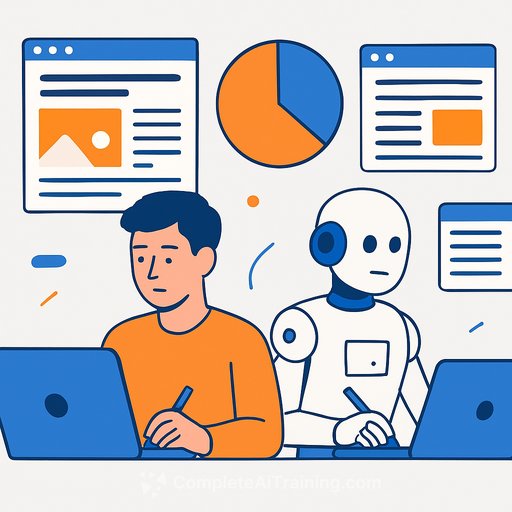The Future of Authorship in the Age of AI: A Field Guide for Working Writers
The line between human and machine writing is getting thin. A recent study from Graphite suggests more than half of web articles are AI-generated. If most of what people read is machine-made, where does that leave you-the person who writes for a living?
The short answer: focused, differentiated, and more valuable-if you adapt with intention.
Beyond panic or praise
Media shifts always split people into two camps: the doomers and the cheerleaders. Decades ago, Umberto Eco called them the "apocalyptics" and the "integrated." His point still stands: both extremes miss the nuance of how people actually use tools and how power moves around them.
AI isn't a threat or a miracle. It's a tool that amplifies whatever process you bring to it-good or sloppy. Your job is to design a process that compounds your edge.
Eco's framework is a useful mental model here.
What "AI content" actually covers
The bulk of AI-written articles are formulaic: quick news updates, how-to pieces, lifestyle posts, reviews, product explainers. The goal is to inform or persuade at scale, not to express originality. That's why AI thrives there-and why many freelance gigs tied to SEO filler and basic copy have been squeezed.
- Think weekend city listicles, generic cover letters, and templated web copy.
- Speed and sameness are the features, not the bugs.
Deepfakes showed the pattern
In 2024, many warned of a "deepfake apocalypse." Research shows people aren't great at spotting manipulated media-and often overestimate their skill. Yet post-election reviews found no clear evidence deepfakes changed the final result.
Lesson for writers: hype cycles exaggerate. Real risks exist (trust erosion, polarization), but the sky doesn't fall overnight. Systems shift, incentives shift, and the professionals who adapt keep their footing.
Authorship is getting collaborative
As more writing blends human drafts with AI expansion and human editing, the question "Who wrote this?" matters less than "Is this useful and does it sound like a real person?" Many writers already use AI for structure, polish, or translation support. The trick is keeping your fingerprints on the work.
AI can nudge you toward average phrasing and Western-English defaults. If you're not careful, your voice flattens. That's the risk.
Practical playbook: Use AI without losing your voice
- Create a voice guide: tone, cadence, banned phrases, signature lines. Feed it to your assistant before drafting.
- Use AI for structure and speed; you handle substance: reporting, interviews, data, lived experience, and taste.
- Write a messy pass, then let AI tighten. Don't let it invent facts. You own verification.
- Keep a "specifics" file: sensory details, field notes, quotes, stories. Sprinkle them to prevent sameness.
- Protect cultural texture: keep idioms and multilingual edges. Don't sand everything down to generic English.
- Run a sameness check: flag clichés, obvious analogies, and filler. Replace with concrete examples.
Where humans win (and will keep winning)
- First-hand observation and original reporting.
- A strong point of view-and the courage to hold it.
- Novel synthesis across disciplines and subcultures.
- Trust with a community: conversation, feedback loops, reputation.
Business moves that age well
- Price for outcomes, not word count. Sell conversion, sign-ups, retention, or time saved.
- Offer what AI can't own: interviews, source development, brand voice leadership, editorial strategy.
- Productize your thinking: newsletters, paid briefings, courses, templates, playbooks.
- Own distribution: email list, private community, events. Don't depend on one platform's algorithm.
Quality control for AI-heavy workflows
- Fact-check every claim. Cite primary sources when possible.
- Track provenance: what was AI-assisted vs. human-crafted. That transparency builds trust with clients.
- Use critique loops: generate, self-critique, regenerate. Or have AI play editor against a checklist.
- Write "cold turkey" regularly to keep your creative muscles from atrophying.
The data problem AI can't solve for itself
Models are increasingly trained on AI-written text, which can degrade quality over time-a known issue sometimes called "model collapse." That makes fresh, human-created writing more valuable as training fuel and as a signal of quality in the wild.
If you produce work with real-world texture, you sit upstream of the average. That's a durable position. For a technical overview, see the research on training models on their own outputs here.
Become hard to average
- Go specific: niche topics, subcultures, proprietary data, or a distinct lens.
- Develop a signature format: teardown, memo, field report, visual brief.
- Publish artifacts of thinking: research logs, process notes, annotated sources.
- Make things offline-interviews, site visits, experiments-that feed online writing.
Tools and ongoing learning
If you want to level up your stack and workflow, explore curated resources built for working professionals. Start with AI tools for copywriting and role-specific training paths.
Bottom line
AI will keep handling generic, low-stakes content. That doesn't erase writers; it pushes us to double down on voice, reporting, taste, and judgment. Use the machines for leverage. Keep the meaning for yourself-and for your readers.
Your membership also unlocks:





